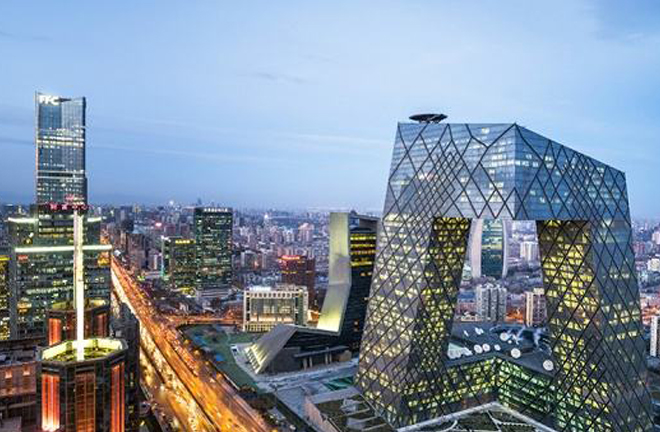Companies seek better prospects in massive transformation

About 80% of Chinese top 500 private enterprises have voluntarily decided to transform and upgrade, a recent report says. Photo: FILE
Chinese companies are pushing a massive transformation amid economic restructuring. The approaches include sector upgrading, independent innovation, environmental protection as well as the integration of informatization and industrialization. This is a unique phenomenon in the history of the global economy in terms of its brisk pace and fundamental impact.
Taking private enterprises as an example, the “2019 Report on China’s Top 500 Private Enterprises” by the China Federation of Industry and Commerce shows that about 80% of these enterprises have voluntarily decided to transform and upgrade for the sake of stronger competitiveness and bigger scale.
The transformation of Chinese enterprises reflects their choice to adapt to the great changes in their environment. It also reveals how China, the world’s largest developing country, navigates its economy confidently despite the complicated international environment and difficult domestic economic structure.
The booming digital economy serves as a testament to this. In 2018, China’s digital economy totaled 3.13 trillion yuan, accounting for 34.8% of the national GDP. The continuous development of leading internet companies such as Alibaba and Tencent have contributed to this trend.
“In 2019, Chinese enterprises’ digital transformation scored 45 points on average, more than 20% higher than the 37 points in 2018,” according to Accenture China Digital Transformation Index report. Digital technology has empowered sector leaders with new weapons and development momentum so that they can have a bigger say in and stay confident about future challenges.
Innovation is a huge source of transformation. In 2018, the central industrial enterprises had established state-level R&D institutions, and central enterprises’ R&D expenditures accounted for about a quarter of the country’s total figure. Of the top 500 private enterprises, 76.6% honed their key technology through innovation, and 65.4% of them implemented technological transformation and equipment upgrades.
The accelerated transformation of Chinese companies is necessary and proactive. Regarding the international situation, the world economy has remained in a period of adjustment since the outbreak of the 2008 financial crisis. The uncertainty of global economic growth is deepening as the total supply and demand of the world economy has undergone tremendous changes. Domestically, such factors cloud China’s economic expansion as the intensified structural contradictions, overcapacity pressure and the contradiction between resources and environment push China to speed up economic adjustment and transformation. In 2014, China put forward the concept of the “new normal” in which economic development would no longer pursue double-digit growth, instead striving to realize sustainability and high quality.
Traditional industries used to be driven by low cost. This unhealthy growth model urgently requires transformation and upgrading. Major manufacturers such as Guangdong and Zhejiang provinces have taken steps to achieve this goal. In 2018, the added value of Guangdong’s advanced manufacturing industry accounted for nearly 60% of the province’s above-scale industrial added value. In Zhejiang Province, two-thirds of the 71,000 robots are serving traditional industries.
The world today is at the height of a technological revolution. Countries, especially the developed nations, are also modifying their industrial structure. China is poised to embrace the tide and take over as a world leader of innovation.
No metamorphosis is painless. No transformation is undemanding. Chinese companies have the greatest pressure ever for transformation, but the prospects are infinitely bright.
Shenyang Machine Tool Group’s new technologies and products represented by the i5 intelligent machine tools are in short supply because of their innovation when the downward economic pressure damaged the machine tool manufacturing industry in Northeast China’s Liaoning Province. In Western China, Panjiang Civil Explosives in Guizhou Province adopted the transformation and upgrading project provided by a Guizhou cloud platform that integrates big data with intelligent manufacturing. After transformation, a workshop only needs 15 laborers to finish the workload previously done by 50 laborers.
China has climbed up the ranks on the Global Innovation Index and other lists, moving from the 29th position in 2011 to the 17th in 2018. It ranks the highest among developing countries, according to the recent “Innovative China: New Engine of Economic Growth” report jointly released by the World Bank, the Development Research Center of the State Council and the Ministry of Finance.
What is central to China’s future economic transformation and upgrading? Economists hold that the domestic market is at the core, in which entrepreneurship plays a major part. Such transformation demands institutional reform. A set of reforms have been formulated concerning how to reshape a competitive environment, ease the burden on enterprises, reduce the cost of innovation and aid traditional sectors with greater financial support. These drastic reforms aim to overcome obstacles in the transformation and upgrading of sectors and companies.
This article was translated from Economic Information Daily.
edited by MA YUHONG
